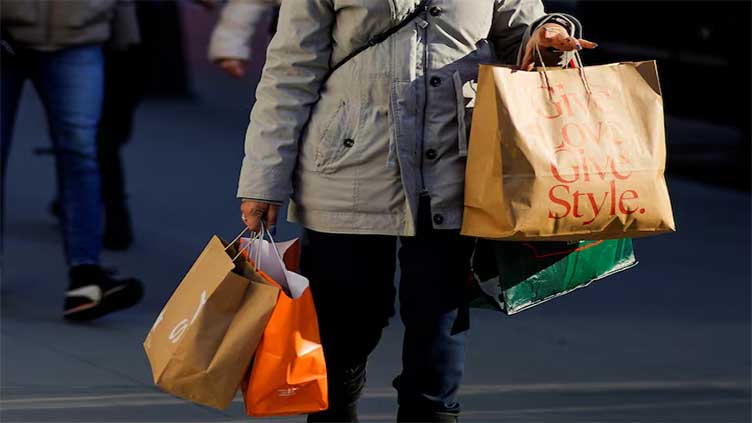US consumer spending solid; inflation showing progress as year ends

Business
The Commerce Department report showed moderate monthly rises in prices - smallest gain in six months
WASHINGTON (Reuters) – US consumer spending increased in November amid strong demand for a range of goods and services, underscoring the economy's resilience, which saw the Federal Reserve this week projecting fewer interest rate cuts in 2025 than it had in September.
There was also good news on inflation last month after a series of warmer readings. The report from the Commerce Department showed moderate monthly rises in prices, with a measure of underlying inflation posting its smallest gain in six months. Nonetheless, the annual increase in core inflation, excluding food and energy, remained stubbornly well above the US central bank's 2% target.
There are also worries that plans by President-elect Donald Trump's incoming administration to cut taxes, impose or raise tariffs on imports and deport millions of undocumented immigrants would stoke inflation.
"The economy continues to grow from strong consumer demand as income growth and the wealth effect from higher portfolio values give consumers capacity to spend," said Jeffrey Roach, chief economist at LPL Financial. "Inflation was more benign than expected but the stickiness of some categories supports the Fed's hesitancy to materially lower rates next year."
Consumer spending, which accounts for more than two-thirds of US economic activity, rose 0.4% last month after a downwardly revised 0.3% gain in October, the Commerce Department's Bureau of Economic Analysis said.
Economists polled by Reuters had forecast consumer spending advancing 0.5% after a previously reported 0.4% rise in October.
The nearly broad-based increase in spending was led by new motor vehicles, likely in part as households replaced vehicles damaged during Hurricanes Helene and Milton. That accounted for the bulk of the 0.8% rebound in goods outlays.
Spending on recreational goods and vehicles also rose as did outlays on financial services and insurance, mostly charges, fees and commissions. There was also increased spending on recreation services, healthcare, clothing and footwear, furniture as well as housing and utilities.
Spending at restaurants and bars as well as on hotel and motel stays also increased. Spending on services rose 0.2%.
When adjusted for inflation, consumer spending rose 0.3% after edging up 0.1% in October. The so-called real consumer spending is running at an annualized rate of 3.1% in the first two months of the fourth quarter.
"That will lay the foundation for another very solid GDP number for the fourth quarter," said Lou Crandall, chief economist at Wrightson ICAP.
Consumer spending surged at a 3.7% pace in the third quarter, the fastest in 1-1/2 years, helping to propel the economy to a 3.1% growth rate following a 3.0% pace of expansion in the April-June quarter.
The Atlanta Fed is forecasting gross domestic product increasing at a 3.1% rate in the fourth quarter.
Fed Chair Jerome Powell on Wednesday described the economy as having "just been remarkable," adding "I feel very good about ... the performance of the economy and we want to keep that going." The central bank on Wednesday cut its benchmark overnight interest rate by 25 basis points to the 4.25%-4.50% range. It forecast only two rate reductions in 2025, in a nod to the economy's continued resilience and still-high inflation.
In September, Fed officials had forecast four quarter-point rate cuts next year. The shallower rate cut path in the latest projections also reflected uncertainty over policies from the incoming Trump administration.
Stocks on Wall Street traded higher. The dollar slipped against a basket of currencies. US Treasury yields fell.
STRONG WAGE GAINS
Labor market stamina, marked by low layoffs and strong wage growth, is underpinning consumer spending. Strong household balance sheets, reflecting high stock market and home prices are also driving spending. Household savings remain supportive.
Economists, however, cautioned that it was mostly middle- and higher-income households that were benefiting from the wage gains and wealth effects, noting that lower-income consumers were under financial pressure.
Personal income rose 0.3%, with wages shooting up 0.6%. Income at the disposal of households after accounting for inflation rose 0.2%, meaning some tapped their savings to fund purchases. The saving rate dipped to 4.4% from 4.5% in October.
Economists did not believe that the moderation in inflation last month would have changed the tone of the Fed's message on Wednesday. The personal consumption expenditures (PCE) price index rose 0.1% after an unrevised 0.2% gain in October.

Goods prices were unchanged after three straight monthly decreases. Motor vehicle prices increased 0.7%, but the cost of recreational goods and vehicles fell for the fourth consecutive month. Services prices rose 0.2% after gaining 0.4% in October.
Housing inflation increased at the slowest pace since April 2021, reflecting a moderation in rents. The cost of food and accommodation services rose by the most in 10 months.
In the 12 months through November, the PCE price index advanced 2.4% after rising 2.3% in October.
The increase in the annual inflation rate was partly due to last year's low readings dropping out of the calculation.
Excluding the volatile food and energy components, the PCE price index climbed 0.1%. That was the smallest rise since May, and followed an unrevised 0.3% gain in October. Core inflation was running at a 2.5% rate in the last three months.

In the 12 months through November, core prices increased 2.8% after advancing by the same margin in October.
The Fed tracks the PCE price measures for monetary policy. It hiked its policy rate by 5.25 percentage points between March 2022 and July 2023.
"The general disinflation trend, in view of the much higher US dollar, is intact for the next two months," said Brian Bethune, an economics professor at Boston College. "However, if the incoming administration raises tariffs significantly, that will provoke retaliation and usher in a period of stagflation that will rival the stagflation of the 1970s."



